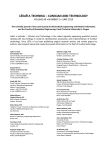-
Články
Top novinky
Reklama- Vzdělávání
- Časopisy
Top články
Nové číslo
- Témata
Top novinky
Reklama- Kongresy
- Videa
- Podcasty
Nové podcasty
Reklama- Kariéra
Doporučené pozice
Reklama- Praxe
Top novinky
ReklamaWrist rehabilitation with manipulator to perform passive and active exercises
Autoři: Piotr Kuryło 1; Joanna Cyganiuk 1; Peter Frankovský 2; Marianna Trebuňová 3
Působiště autorů: Institute of Machine Design and Operation, Faculty of Mechanical Engineering, University of Zielona Gora, Poland 1; Department of Applied Mechanics and Mechanical Engineering, Faculty of Mechanical Engineering, Technical University of Košice, Slovakia 2; Department of Biomedical Engineering and Measurement, Faculty of Mechanical Engineering, Technical University of Košice, Slovakia 3
Vyšlo v časopise: Lékař a technika - Clinician and Technology No. 2, 2019, 49, 52-57
Kategorie: Původní práce
Souhrn
The paper characterizes basic dysfunctions and diseases of a human wrist as well as describes the mechanics and pathomorphology of the human hand. The radial-carpal joint was analyzed in terms of its ranges of motion. The results of the analysis, i.e. the number of degrees of freedom for a free hand, are included. The concept of manipulator construction for optimal rehabilitation of the wrist was developed. Expected effects of the exercises, which can be implemented on the designed manipulator, were also described. A comparative analysis of other appliances supporting the rehabilitation of the human upper limb were presented. The main purpose of the designed manipulator was to gain full control of implementation of exercises performed by the patient and to archive and precisely track the progress in the rehabilitation. An important feature of the designed manipulator is its versatility enabling its use for: exercises of both hands (left and right) with the repetitive movements, choose of exercises (active and passive movements), choose of the degree of disability of the patient.
Klíčová slova:
rehabilitation manipulator – Wrist – rehabilitation
Zdroje
- http://chirurgiareki.pl/userfiles/pdf/27Pl.pdf [Internet]. [cited 2018 Jan 12].
- Tejszerska D. Biomechanika narządu ruchu człowieka. Wyd. ITEW, Gliwice – Radom. 2011;247–253.
- Trawiński K. Kosci reki [Internet]. [cited 2018 Jan 11]. https://www.medianauka.pl/kosci-reki.
- http://anatomia.wyklady.org/wyklad/966_stawy-i-ruchy-obreczy-konczyny-gornej_strona-4.html [Internet]. [cited 2018 Jan 2].
- http://www.fizjoterapeutom.pl/files/13/rehabilitacja_reki.pdf [Internet]. [cited 2018 Jan 3].
- Sobieszczyk S. Modelowanie biomechaniczne, Wyd. PG, Gdańsk. 2006;7–12.
- Gilroy AM. Atlas anatomi. Wyd. MedPh, Warszawa.
2011;300–7. - Živčák J, Knežo D. Biomechanika hybnosti. 1st ed. Prešov: Prešovská univerzita; 2007. 205 p. ISBN 978-80-8068-675-8.
- Kilar JZ. Leczenie ruchem. Kraków 1996, Wydawnictwo Firma Handlowo - Usługowa KASPER. pp. 67-73.
- Živčák J, Michalíková M, Tóth T, Bednarčíková L. Goniometria pohybovej sústavy človeka, 1. ed. Košice: TU; 2012. 297 p. ISBN 978-80-553-0532-5.
- Matejko B. Idea protez bionicznych w nowoczesnej protetyce. Zeszyty Naukowe. 2010;1 : 185–9.
- Giesko T. Model mechatronicznego systemu do wspomagania rehabilitacji ruchowej. Problemy Eksploatacji. 2012;2 : 68–71.
- Mikołajewska E. Wykorzystanie robotów rehabilitacyjnych do usprawniania. Niepełnosprawność-zagadnienia, problemy, rozwiązania. 2013;9(4):21–44.
Štítky
Biomedicína
Článek vyšel v časopiseLékař a technika

2019 Číslo 2-
Všechny články tohoto čísla
- Effect of the zinc phthalocyanine mediated photodynamic therapy on cytoskeletal apparatus of hela cells
- A framework to assess mechanics of stump–socket interaction in transfemoral amputees
- Wrist rehabilitation with manipulator to perform passive and active exercises
- Methods evaluating upper arm and forearm movement during a quiet stance
- An analysis of neural activity of the human basal ganglia in dystonia: a review
- Lékař a technika
- Archiv čísel
- Aktuální číslo
- Informace o časopisu
Nejčtenější v tomto čísle- Methods evaluating upper arm and forearm movement during a quiet stance
- Effect of the zinc phthalocyanine mediated photodynamic therapy on cytoskeletal apparatus of hela cells
- Wrist rehabilitation with manipulator to perform passive and active exercises
- A framework to assess mechanics of stump–socket interaction in transfemoral amputees
Kurzy
Zvyšte si kvalifikaci online z pohodlí domova
Autoři: prof. MUDr. Vladimír Palička, CSc., Dr.h.c., doc. MUDr. Václav Vyskočil, Ph.D., MUDr. Petr Kasalický, CSc., MUDr. Jan Rosa, Ing. Pavel Havlík, Ing. Jan Adam, Hana Hejnová, DiS., Jana Křenková
Autoři: MUDr. Irena Krčmová, CSc.
Autoři: MDDr. Eleonóra Ivančová, PhD., MHA
Autoři: prof. MUDr. Eva Kubala Havrdová, DrSc.
Všechny kurzyPřihlášení#ADS_BOTTOM_SCRIPTS#Zapomenuté hesloZadejte e-mailovou adresu, se kterou jste vytvářel(a) účet, budou Vám na ni zaslány informace k nastavení nového hesla.
- Vzdělávání



